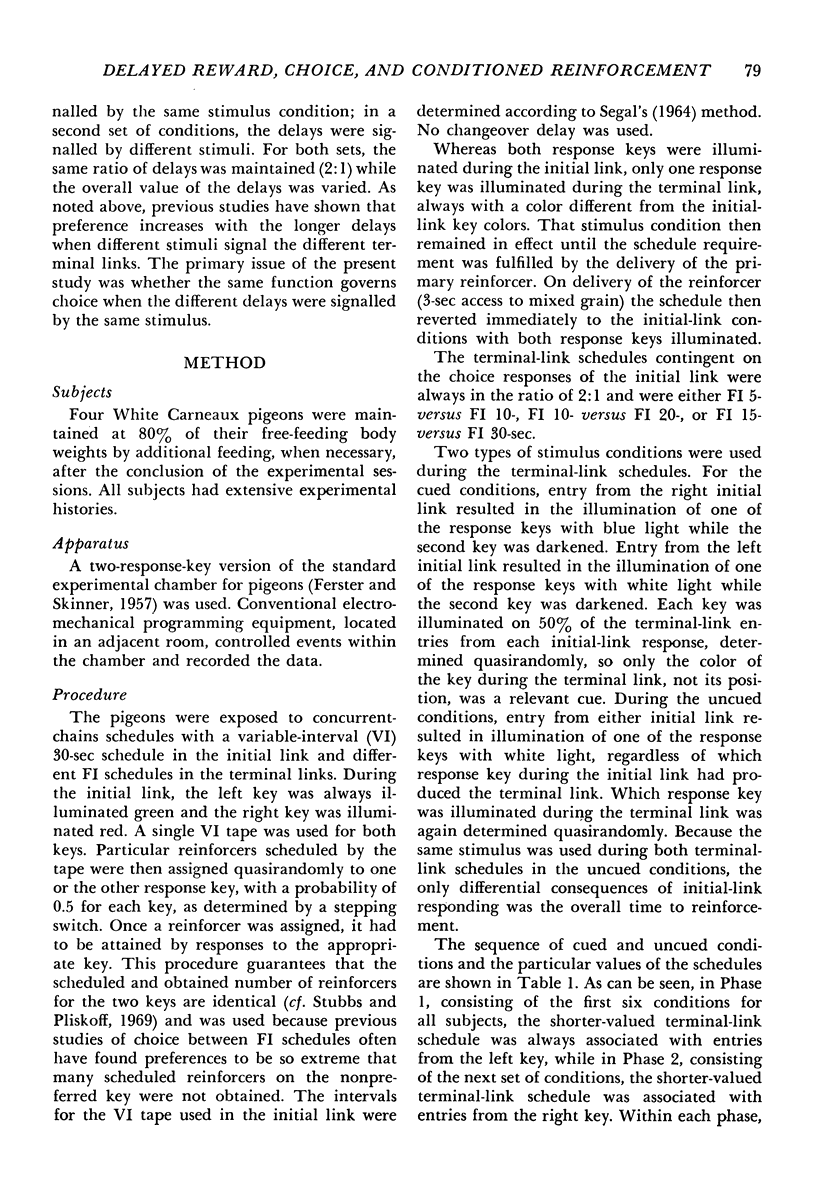Abstract
Pigeons chose between fixed-interval schedules of different durations presented in the terminal links of concurrent-chains schedules. The pair of schedules was always in the ratio of 2:1, but the absolute duration of the fixed intervals varied. In one set of conditions, the different terminal-link schedules were associated with different keylight stimuli (cued conditions). In a second set of conditions, the different terminal-link schedules were associated with the same stimulus (uncued conditions). Results from the cued conditions replicated previous findings that preference for the shorter fixed-interval schedule increased with fixed-interval duration. Preferences in the uncued conditions were lower than in the corresponding cued conditions but also increased with fixed-interval length. In addition, the degree of control under the uncued conditions was correlated with the extent to which the schedule during the terminal link was discriminated immediately upon entry into the terminal link. The pattern of results in both conditions was inconsistent with the notion that choice behavior matches relative immediacy of reinforcement. Reanalysis of previous evidence for matching (Chung and Herrnstein, 1967) showed that matching in fact did not occur, as the preferences of their subjects for the shorter of two delays also increased with the absolute size of the delays.
Keywords: reinforcement delay, conditioned reinforcement, choice, reinforcement immediacy, cued conditions, uncued conditions, fixed-interval schedules, concurrent chained schedules, pigeons
Full text
PDF









Selected References
These references are in PubMed. This may not be the complete list of references from this article.
- Baum W. M. On two types of deviation from the matching law: bias and undermatching. J Exp Anal Behav. 1974 Jul;22(1):231–242. doi: 10.1901/jeab.1974.22-231. [DOI] [PMC free article] [PubMed] [Google Scholar]
- Baum W. M., Rachlin H. C. Choice as time allocation. J Exp Anal Behav. 1969 Nov;12(6):861–874. doi: 10.1901/jeab.1969.12-861. [DOI] [PMC free article] [PubMed] [Google Scholar]
- Chung S. H. Effects of delayed reinforcement in a concurrent situation. J Exp Anal Behav. 1965 Nov;8(6):439–444. doi: 10.1901/jeab.1965.8-439. [DOI] [PMC free article] [PubMed] [Google Scholar]
- Chung S. H., Herrnstein R. J. Choice and delay of reinforcement. J Exp Anal Behav. 1967 Jan;10(1):67–74. doi: 10.1901/jeab.1967.10-67. [DOI] [PMC free article] [PubMed] [Google Scholar]
- Davison M. C., Temple W. Preference for fixed-interval schedules: an alternative model. J Exp Anal Behav. 1973 Nov;20(3):393–403. doi: 10.1901/jeab.1973.20-393. [DOI] [PMC free article] [PubMed] [Google Scholar]
- Davison M. C., Temple W. Preference for fixed-interval terminal links in a three-key concurrent chain schedule. J Exp Anal Behav. 1974 Jul;22(1):11–19. doi: 10.1901/jeab.1974.22-11. [DOI] [PMC free article] [PubMed] [Google Scholar]
- Fantino E. Choice and rate of reinforcement. J Exp Anal Behav. 1969 Sep;12(5):723–730. doi: 10.1901/jeab.1969.12-723. [DOI] [PMC free article] [PubMed] [Google Scholar]
- HERRNSTEIN R. J. APERIODICITY AS A FACTOR IN CHOICE. J Exp Anal Behav. 1964 Mar;7:179–182. doi: 10.1901/jeab.1964.7-179. [DOI] [PMC free article] [PubMed] [Google Scholar]
- Killeen P. Preference for fixed-interval schedules of reinforcement. J Exp Anal Behav. 1970 Sep;14(2):127–131. doi: 10.1901/jeab.1970.14-127. [DOI] [PMC free article] [PubMed] [Google Scholar]
- Macewen D. The effects of terminal-link fixed-interval and variable-interval schedules on responding under concurrent chained schedules. J Exp Anal Behav. 1972 Sep;18(2):253–261. doi: 10.1901/jeab.1972.18-253. [DOI] [PMC free article] [PubMed] [Google Scholar]
- Neuringer A. J. Delayed reinforcement versus reinforcement after a fixed interval. J Exp Anal Behav. 1969 May;12(3):375–383. doi: 10.1901/jeab.1969.12-375. [DOI] [PMC free article] [PubMed] [Google Scholar]
- SEGAL E. F. A RAPID PROCEDURE FOR GENERATING RANDOM REINFORCEMENT INTERVALS ON VI AND VR TAPES. J Exp Anal Behav. 1964 Jan;7:20–20. doi: 10.1901/jeab.1964.7-20. [DOI] [PMC free article] [PubMed] [Google Scholar]
- Squires N., Fantino E. A model for choice in simple concurrent and concurrent-chains schedules. J Exp Anal Behav. 1971 Jan;15(1):27–38. doi: 10.1901/jeab.1971.15-27. [DOI] [PMC free article] [PubMed] [Google Scholar]
- Stubbs D. A., Pliskoff S. S. Concurrent responding with fixed relative rate of reinforcement. J Exp Anal Behav. 1969 Nov;12(6):887–895. doi: 10.1901/jeab.1969.12-887. [DOI] [PMC free article] [PubMed] [Google Scholar]
- Wardlaw G. R., Davison M. C. Preference for fixed-interval schedules: effects of initial-link length. J Exp Anal Behav. 1974 Mar;21(2):331–340. doi: 10.1901/jeab.1974.21-331. [DOI] [PMC free article] [PubMed] [Google Scholar]


